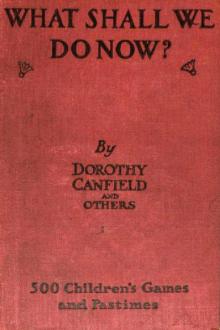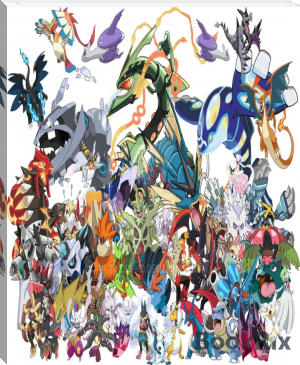What Shall We Do Now? by Dorothy Canfield Fisher (books on motivation .TXT) 📖

- Author: Dorothy Canfield Fisher
- Performer: -
Book online «What Shall We Do Now? by Dorothy Canfield Fisher (books on motivation .TXT) 📖». Author Dorothy Canfield Fisher
"Charades" can be written in advance and carefully rehearsed, but in this book we are concerned more nearly with those that are arranged a few minutes (the fewer the better) before they are performed. As a rule a word of two or three syllables is chosen, the syllables are first acted, then the whole word, and then the audience guess what it was. Sometimes the word is brought in, both in its complete form and in its syllables; and sometimes—and this is perhaps the better way—it is acted. Thus, if the word were "Treason," one way would be to make the acts themselves anything that occurred to you, merely saying "Tree" with some distinctness in the first; "Son" or "Sun" in the second; and "Treason" in the third. The other and more interesting way would be to make the first act relate to tree-felling or tree planting, or, say, a performance by Mr. Tree; the second to a son or the sun; and the third to some treasonable situation, such as, for example, the Gunpowder Plot. On account of the time which is occupied in preparing and acting it is better to choose two-syllabled words—which, with the whole word, make three scenes—than three- or four-syllabled ones; although there are certain four-syllabled words which split naturally into two halves of two syllables each. "Parsimony," for example, could be performed: Parsee, money, parsimony. As a general rule the charades that are arranged during the evening are better performed in dumb show, with plenty of action, than with any talking at all. Under the circumstances gestures are so much easier than words and not any less amusing.
Dumb PerformancesVery good fun can be had also from impromptu pantomimes, where the performers enact some story which every one knows, such as "Aladdin" or "Red Riding Hood" or "Cinderella"; or a scene from history proper, or from village or family history. The contrast between the splendor of Cinderella's carriage in the story and the old perambulator which has to serve in the charade only adds to the fun. Every one, being dumb, acts to the utmost. It is sometimes more amusing if all the parts are turned upside down and a boy plays the heroine and a girl the hero. Where the scene is too tremendous for any representation to be given, it is best to meet the case frankly and use, as they did in Shakespeare's day, written labels, such as "This is Aladdin's Palace."
Dressing UpIt is, of course, much more fun to dress up; but dressing up is not so important that a charade is spoiled without it. If, on the day of your party, you know that charades will play a part in it, it is wise to put in a convenient room a number of things suitable to dress up in. Then at the last minute there need be no furious running up-stairs to pull things out of closets and boxes, and the unpleasantness will be avoided which sometimes follows when you have taken somebody's best clothes for a rather violent performance.
Almost the best garment there is for dressing-up purposes is a fur coat. While priceless for Red Riding Hood's wolf it will make also most of the other animals in the Zoo. A soldier's uniform is a great possession, and a real policeman's helmet has made the success of many charades. Most kinds of hat can, however, easily be made on the morning of a party out of brown paper. Epaulettes and cockades are also easily made of the same material. Powder or flour for white hair, some corks for moustaches and beards (you hold them in the candle for a minute and wait till they are cool enough to use), and a packet of safety-pins should be in handy places. Cherry tooth-paste makes serviceable rouge.
Tableaux Vivants"Tableaux Vivants" are a change from acting, but they need, if done at all well, a great deal of preparation and rehearsal, and are therefore perhaps better left to older people. But quickly-arranged groups representing (not too seriously) scenes in American history might be good fun.
Remarks on ActingThe drawback to all charades and dressing up at a party is that they make away with so much valuable time of the players who are out of the room, and unsettle those who are left in. It should be the first duty of every one taking part in acting at parties to decide quickly on the subject or word, and to perform it quickly. Many and many a party has been spoiled by the slowness of the actors outside. Historical or family scenes with no dressing up and some action are perhaps better than much dressing up and absolute stillness. In "Canute and the Waves," for example, it is better that the incoming tide should be represented by a boy rolling slowly over the carpet than that there should be nothing but fixed eyes and stern faces.
RAINY-DAY GAMES RAINY-DAY GAMESThis is a chapter written to meet the needs of several children shut up together in bad weather. The chapter on "Indoor Occupation and Things to Make" gives suggestions for a single child, but here are a few suggestions for several occupations for a group of children, which do not mean the destruction of the furniture.
Any one of the games given in the chapter "In the Train" is suitable for rainy days.
There are of course many games treated elsewhere in this book which can be played on rainy days indoors. Many of the parlor and outdoor games are equally suitable for indoors. All the card games and back-gammon, checkers, etc., are invaluable resorts in case of a long dreary day, but there are a few other recreations which, in some families are saved for such occasions.
Bean-BagsOne of these is the old fashioned game of bean-bag. One rainy morning can be spent in making the outfit. The girls can be occupied in making the cloth bags, from six to ten inches square, partly filled with beans: and the boys in making the board which is shown in the illustration.
It should be about three feet square of any sort of boards and propped up at one side so that it forms an inclined plane. Five holes are cut in it, about seven inches square, all but the centre one which is only five inches square. The players stand off from six to twelve feet according as their skill increases with practice and try to throw the bags through the holes. There are various rules for playing the game which you can arrange to suit yourself, or to make a change. One way is have the bags in sets of six, each six being of one color, different from the others. The players stand in a line and all throw at once, trying to get their six bags in the holes as soon as possible. When they have thrown their bags they rush up to the board, gather up those which have gone wild and run back to the firing line. The one who gets his six bags in first wins the game. A bag thrown through the small centre hole counts as two.
Another way to play it is to throw in turn, each throwing all his six bags one after another. The one who gets most in is the winner.
Ring-TossRing-toss is another game in which skill can be acquired only through practice and it is very good for rainy-days. It is really indoor quoits, and is a favorite game for shipboard. Any one with a little patience and care can make the rings which are of rope fastened together with slanting seam, wound with string so that there is no bulging, overlapping hump at one side.
A stake is nailed upright to a board (the stake can be a section of an old broom handle, or a smooth, small, straight peeled branch of a tree) and the outfit for the game is complete. It is played with the same rules as quoits (see "Outdoor Games for Boys"), and a very considerable degree of skill can be obtained by practice. As in pitching quoits, the rings should be thrown with a little level twist to make them whirl about.
Ring-the-NailA variation of this can be played with common large nails and brass curtain rings. Eight nails are driven into a board in a circle, leaving about an inch sticking up. In the centre, one is driven, standing about three inches tall. Small rings, curtain rings, for instance, are thrown toward this. Each time they encircle one of the lower nails is counted five, and the centre nail ten.
Soap-BubblesA soap-bubble race is easy to arrange and very good fun. An old shawl or blanket is laid on a table or the floor, goals are made at each end of it with piles of books, leaving an opening between, and each person is provided with a pipe for blowing bubbles. One bowl of soap-bubbles is enough for the company (see page 279 on the best way to make lasting soap-bubbles). The game is to see who can most quickly blow a bubble, deposit it on the woolen cloth at one end and blow it through the goal at the other. Of course you try to direct your puffs so that you will not only blow your own bubble along but will force your opponent's back.
Another way is to stretch a cord across the room and divide into two sides, standing three feet from the cord. At a given signal dip your pipes in the bowl of soap-suds, blow a bubble, and try to blow it over the cord. The side which succeeds in landing most bubbles in the enemy's territory wins.
Jack-StonesA game which is good, quiet fun for a rainy day is Jack-stones. Although not played much nowadays it is very interesting and is to indoors what "mumble-the-peg" is to outdoors. It is played usually with small pieces of iron with six little feet: but it can also be played with small pebbles all of a size. All kinds of exercises can be used, many of which you can invent yourself but a few of the commonest are given below. 1. The five stones are thrown up and caught on the back of the hand. 2. Four of the stones are held in the hand while one is thrown up. They must then be laid on the table, or floor, in time to catch the stone before it comes down. It is then thrown up again, and the four stones are picked up either one at a time or all together, and the stone caught again.
Nearly all the exercises are variations of this. One stone is thrown up and different things must be done quickly with the others before it falls again.
Tying KnotsAnother occupation for rainy days that will interest several children (as well as one) is puzzling out the construction of some of the simplest sailor's knots. This is a useful and a very desirable accomplishment. Often several together can solve a difficult knot better than one, and after some proficiency is acquired it is interesting to have a





Comments (0)